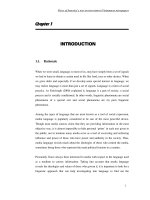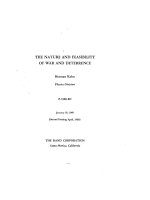the real price of war how you pay for the war on terror
Bạn đang xem bản rút gọn của tài liệu. Xem và tải ngay bản đầy đủ của tài liệu tại đây (3.51 MB, 241 trang )
The Real Price of War
“Worth Paying For,” by Edwin Marcus. Copyright 1941.
THE REAL PRICE
OF WA R
How You Pay for the War on Terror
Joshua S. Goldstein
a
New York University Press
New York and London
NEW YORK UNIVERSITY PRESS
New York and London
www.nyupress.org
© 2004 by Joshua S. Goldstein
All rights reserved
Frontispiece: “Worth Paying For,” by Edwin Marcus.
Copyright 1941.
Library of Congress reproduction number 2a10522.
Reprinted by permission of Donald E. Marcus, whom I thank.
Library of Congress Cataloging-in-Publication Data
Goldstein, Joshua S., 1952–
The real price of war : how you pay for the war on terror /
Joshua S. Goldstein.
p. cm.
Includes bibliographical references and index.
ISBN 0–8147–3161–9 (cloth : alk. paper)
1. War on Terrorism, 2001—Economic aspects.
2. Terrorism—Prevention—Economic aspects—United States.
3. War—Economic aspects—United States.
4. Government spending policy—United States. I. Title.
HV6432.G64 2004
973.931—dc22 2004008513
New York University Press books are printed on acid-free paper,
and their binding materials are chosen for strength and durability.
Manufactured in the United States of America
10987654321
CONTENTS
Preface vii
Introduction 1
Part I Government Spending
1 What Does War Cost? 11
2 Taxes 23
3 Budget Cuts 38
4 Debt 57
Part II Broader Economic Effects
5 Inflation 75
6 Business under Stress 88
7 Profit and Loss in Wartime 107
Part III Future Costs and How We Divide Them
8 The Price of Failure 127
9 A War without Sacrifice? 147
10 Sharing the Burden 162
11 Pay to Win 178
Notes 203
Acknowledgments 221
Index 223
About the Author 229
PREFACE
Although it focuses on the American economy in wartime, this
is not an economics book. As a political scientist and interdisci-
plinary scholar of war, I see the economy as just one of various
arenas in which the effects of war play out. In this book, I trace
the costs and economic effects of the War on Terror, broadly
defined. I sketch the big picture of war funding—the dollars
that come from your pocket and ultimately pay for war-related
needs. Then I show how the economic stresses of war play out
far beyond government budgets, with the conclusion that being
at war exacts a high economic cost—higher the longer the war
goes on. Finally, I question whether we are spending enough on
the War on Terror to have a reasonable chance to end it quickly,
which means that future costs will be higher and harder to
viii
Preface
meet. The book’s three parts reflect three layers of war costs:
first, the money we spend through our government; second,
the private and indirect costs to our economy; and third, the
additional costs we may need to pay in the coming years.
My aim is both to inform and to provoke debate. I hope to
raise questions, to draw attention to underdiscussed issues, and
to help roll back denial about the War on Terror and its costs. I
doubt anyone will agree with all of this book, but I hope every-
one finds some part of it thought-provoking.
I find fault with the administration and Congress during the
first two years of the War on Terror for both conservative and
liberal reasons. Liberal readers may welcome my criticisms of
President Bush and my demonstration of how the high costs of
being at war fall on Americans. But those readers may find less
comfortable my argument that by spending even more on the
War on Terror we could win the war sooner, avoiding a
decades-long fight and perhaps saving our cities from destruc-
tion. President Bush has not adequately funded the war in all
its dimensions—because war funding competes directly with
tax cuts—nor has he mobilized and united the country for the
effort. If we are to defeat global terrorism, I argue, we need to
muster more resources on each of three fronts: the military,
homeland security, and foreign aid/diplomacy. Ending the
war—and what end can there be but winning?—would create
conditions for a more stable and peaceful world order in which
our economy could prosper again. I’m not sure that victory
over all terrorist groups of global reach is possible, but it might
be possible, and if so I’m pretty sure it will need more money.
Our best strategy, in my view, is to spend what it takes now to
get the job done. It won’t be cheaper in future years. And the
way to raise that money, clearly, is to increase wealthy Ameri-
cans’ taxes, among other less important revenue sources.
Preface
ix
The numbers in the book are rounded off and presented on
the scale of a household’s monthly expenditures rather than in
the billions of dollars discussed in national policy debates. This
helps create an understandable big picture of war’s place in the
federal government and the overall economy, although at the
cost of economic precision.
In summarizing the federal government’s finances, I put off
to one side the retirement system, in which payroll taxes fund
Social Security, Medicare, and the federal retirement system.
This makes my analysis of the deficit more alarming than the
official “unified” budget—alarming enough on its own—which
counts $200 billion a year in retirement surpluses as though
they were reductions in current deficits.
In creating a mosaic of life in wartime America, I relied
heavily on journalists’ accounts in local newspapers across the
country—accessible to all of us these days via Google News on
the Internet. Where I have omitted page numbers it is gener-
ally because the story appeared on the publication’s Web site
without a page number. I draw especially on the New York
Times as the nation’s “newspaper of record” and the voice of
New York City, which is the central front in the war at home.
A Web site about the book—www.realpriceofwar.com—
includes further information and a discussion forum.
—Joshua S. Goldstein
Amherst, Massachusetts
February 2004
INTRODUCTION
The first ambulance that arrived at Overlake Hospital Medical
Center in Bellevue, Washington, carried a young woman
named Vivian Chamberlain, screaming in pain and bleeding
from her punctured eardrums. When handheld radiation detec4
tors went wild, she was stripped of her outer clothing, brushed
down by four workers in protective suits, and hosed off with
cold hydrant water. More ambulances followed, as waves of
similar casualties hit Seattle-area hospitals. This was only a
test, part of a simulation in 2003 to improve America’s ability
to respond to a terrorist “dirty bomb” or a biological weapon.
But, as the volunteer-victim Chamberlain told the Seattle
Times, “it was real-life scary.”
1
Also real-life scary were the economic realities at the com4
pany where Chamberlain worked, Boeing. The War on Terror
2
Introduction
has cost Boeing, its workers, and its business partners dearly.
The company laid off thousands of workers in 2003, pushing
Boeing job losses since 9/11 above thirty-five thousand. Boe4
ing’s CEO Phil Condit called it “the worst downturn since air-
planes existed.” As an economist for the state Department of
Employment Security put it, “Everybody knows somebody
who’s been laid off from Boeing.”
2
With people traveling less
since the 9/11 terrorist attacks, airlines going bankrupt, and a
fleet of jets sitting idle in the California desert, there was little
hope of a quick turnaround in Boeing’s fortunes. The troubles
of Boeing, long a mainstay of the Seattle economy and the
aerospace industry, reverberated widely.
The economic costs of this war are not incidental. Terrorists
are targeting our economy and trying to make the war as ex-
pensive as possible. This is a war of attrition designed to
weaken America. Listen to Osama bin Laden, in a videotape
three months after 9/11: America may not be beatable militar4
ily, he said—Al Qaeda had just lost its last major Afghan sanc4
tuary in Tora Bora—but “there is another way through hitting
the economic structure It is very important to concentrate
on hitting the U.S. economy through all possible means.”
3
Al
Qaeda and similar groups could inflict serious economic harm
just by keeping the war going year after year, because it is both
expensive and disruptive of economic life.
As Vivian Chamberlain returned to work at Boeing, the ter4
ror drill over for her, thousands of desperately ill patients
flooded into hospitals in Chicago and were quickly diagnosed
with pneumonic plague from a terrorist biological weapon. In
the suburb of Skokie, triage tents were set up outside Rush
North Shore Medical Center, just one of 157 hospitals respond4
ing. The hospital’s trauma coordinator, Barbara Croak, said,
“We’re in full code triage, full disaster mode.”
4
It was another
phase of the exercise, of course. The majority of victims were
Introduction
3
just faxed in to local hospitals rather than showing up in per-
son. In a real attack, they would need rides in the ambulances
of the Skokie Fire Department, which would also provide para-
medic and rescue services, hazardous materials response, and
disaster management. But “first responders” like the Skokie
Fire Department and similar agencies across the Chicago area
depend on local funding, which has been tight. As the hospitals
filled with fax-victims in 2003, the drug company Pfizer was
closing up shop in Skokie for good, taking with it fifteen hun4
dred Chicago-area jobs and $5 million a year in property taxes
that Pfizer used to pay. Those property taxes used to help fund,
among other things, the Skokie Fire Department.
America’s challenges on two fronts—war and the econ4
omy—are intimately linked, just as Seattle and Chicago resi4
dents practice for civil defense while looking over their
shoulders nervously at layoffs and service cuts. Job losses in
Seattle and Chicago reflected a broader malaise that settled
across the American economy during the first two years of
the War on Terror. The uncertainties of wartime deepened the
economic slowdown of 2001 to early 2003. The worst job
market in a generation—two million jobs lost in two years—
accompanied a succession of corporate bankruptcies, from
Enron to WorldCom to United Airlines. The dollar dropped in
value. World oil prices, a key economic variable, whipped up
and down with the shifting risks related to war and terror—
an instability that undercut growth. Spiraling federal deficits
also reduced confidence, and budget shortfalls forced cutbacks
in safety-net programs. The increased military spending and
the costs of homeland security have piled hundreds of bil4
lions of dollars onto the federal deficit. The war did not create
the economic downswing in 2001–3, which began officially in
the first quarter of 2001 after the dotcom collapse. But the
war added to it.
4
Introduction
Economic growth roared back in late 2003, heading into
election year (that’s how politicians plan it), but two huge
problems remained. First, the rapidly escalating U.S. budget
deficits—partly the result of war spending, partly of histori4
cally unprecedented wartime tax cuts, among other factors—
could weaken the economy (by lowering the dollar’s value and
raising interest rates and prices). Second, another terrorist at-
tack on U.S. soil could disrupt economic life in ways yet un4
known. Historically, in wartime, people consume less and busi4
nesses hold off on investment because of risks and anxieties.
Future terrorist attacks could create a chronic anxiety that
would unsettle the economy, the equivalent of a low-grade
fever. Worse still, our enemies seek nuclear weapons to destroy
our cities. The economic effects of such future terrorist attacks
could be catastrophic. Meanwhile, international trade—an en4
gine of prosperity in the 1990s—would suffer if America closed
its borders in a prolonged period of danger.
Letting the War on Terror drag on for decades would be the
most costly option. Yet that’s just where we seem to be head4
ing. In its early years, the war consumed enough money to
drive up the federal deficit to breathtaking heights, yet—as I
show in the later chapters of this book—not enough money to
really get the job done on any of several “fronts.” I conclude
that our best chance for peace and prosperity requires more
economic sacrifices in the short term as we pursue the war in
all its aspects with greater vigor. Because of his commitment to
tax cuts, President George W. Bush shortchanged the war ef4
fort, especially its nonmilitary components, and failed to mobi4
lize the country behind it.
These truths should be self-evident: The nation is at war.
The war is expensive. Someone has to pay for it. The sooner we
honestly assess the costs and divide them fairly among our-
selves, the sooner we can mobilize the country’s full resources
Introduction
5
for the war. The price is not beyond reach; it will take a smaller
fraction of the national economy than past wars have claimed.
We will have to dig deep in our pockets, but in the end we can
afford the price of this war. What we cannot afford is to stay in
denial about the real price of war. You may disagree with the
policies and methods by which the Bush administration has
fought this war, such as its Iraq campaign, but we must fight
the overall war. We are not going to solve the problem on the
cheap, and we cannot afford to count on getting lucky.
In this war, not to win is to lose. The Bush administration
compiled, in the first two years after 9/11, a perfect record of
zero attacks against the U.S. homeland. The trouble is, there’s
zero—meaning the danger is gone, we have removed the
threat—and then there’s zero meaning it hasn’t happened yet.
We cannot be content with the second kind of zero. Even if we
reduced the odds of a nuclear attack by chasing after terrorists,
disrupting their finances, arresting some leaders, and breaking
up some cells, those odds might not be good enough. Imagine,
for instance, that we reduced the chances of a catastrophic at-
tack on any given day to one-hundredth of 1 percent. If rain
had odds like that, you wouldn’t take an umbrella. But those
odds would look less appealing if the war drags on without end.
The chance of a catastrophic attack within thirty years would
be 80 percent. Nuclear terrorism is not like rain, something we
learn to live with; nuclear terrorism is like rain to the Wicked
Witch of the West, something that can melt us.
Preventing the destruction of our cities must be the central
purpose of the War on Terror and, indeed, of the nation itself.
In this sense, President Bush’s rhetoric about the nature of the
war is not too expansive. He thinks of the War on Terror as a
unified effort that will continue for years and span many
“fronts” and countries. Afghanistan and Iraq were just “bat4
tles,” to use Bush’s term. Worldwide in scope, open-ended in
6
Introduction
time, the War on Terror is at once a desperate struggle to save
American cities from destruction and an ambitious mission ex-
tending to “every dark corner of the earth” (again Bush’s
phrase, in 2003).
5
Bush may be wrong about the mix of mili4
tary and nonmilitary means, about how and why he fights mil4
itary campaigns, and about having God on his side in fighting
“evil,” but the war itself matters as much as he says it does.
This expansive view of the scope of the war cannot, however,
coexist with a long-duration war that lasts for generations.
Rather, we must end the war in years, not decades.
Ending the war means winning the war. Given the nature of
Al Qaeda and related groups, the only end for the war is to put
out of business all such terrorist organizations of global reach.
Is this a big job? Yes. Is it impossible? No. Few terrorists have
global reach, and few of those have the resources and popular
base of Al Qaeda and its network of affiliated groups world-
wide. The Iraq war aside, the hunt for terrorists has the support
of virtually all the world’s governments and the legitimacy of
UN backing. The United States, most powerful country in the
history of the world, the country that won World War II in less
than four years, can defeat Al Qaeda and its affiliates.
As I discuss toward the end of the book, I think this effort
will require much more than military means. In some ways, we
need to remake the world and America’s place in it. So when I
speak of the “war,” I do not mean only, or even primarily, mili4
tary campaigns.
How to win the War on Terror is not the subject of this
book. How to pay for it is. Both questions are politically con4
tentious, but they are not the same question. Whatever dis4
agreements about strategy Americans may have, any successful
strategy will be expensive. The problem of paying for the war
will be with us in the coming years, no matter who occupies
the Oval Office. The president in 2005 will have on his plate an
Introduction
7
unfinished job in Afghanistan, ongoing attacks in Iraq, vast
backlogged needs in homeland security, a tide of anti-Ameri4
canism worldwide, and U.S. conflicts with major allies who
must help us if we are to defeat terrorism. None of it will be
cheap to solve.
Raising needed resources for the War on Terror is politically
problematic because it is a distributional issue on which the in4
terests of Americans diverge. Seemingly, nobody wants to pay
more than their share, and the politics of government spending
dictate that an undue burden will fall on those either too weak
to protect their interests or patriotic enough to shoulder a
heavy load voluntarily. For instance, the National Guard and
reservists discussed at the end of Chapter 7 sacrifice by risking
harm and being separated from their families, but they also
take huge financial losses in going from civilian to military pay
for extended periods. Congress could more equitably distribute
the burden of war by making up these pay reductions and pass4
ing on the bill to all of us in the form of slightly higher taxes.
Or it could force companies to make up their reservist employ4
ees’ lost pay, as a few companies such as IBM already do. But
raising taxes and loading regulations on companies are politi4
cally unpopular proposals, especially for Republicans.
The political difficulties around paying for the War on Ter4
ror in its first few years left the fight against terrorism with in4
adequate resources on all its fronts—from distant regime
change, to homeland security, to the battle for worldwide public
opinion. Given the high price of war, the high price of failure,
and the political difficulties of getting Americans to pay more
taxes, one can understand why politicians would rather not face
up. But denial is no substitute for policy.
The Real Price of War makes three central arguments. First,
the war is more expensive than you thought, especially if you
include hidden, indirect, and future costs. Second, we have little
8
Introduction
choice but to pay the price, and probably a rising price, in the
coming years. Third, President Bush and the Congress have not
been honest with the public about the real price of this war,
which competes with tax cuts and other political priorities, so
we still need a debate about how we split the bill for war. Lib4
eral readers will need to consider the possibility that the war
deserves even more money and attention than President Bush
has given it; conservative readers will need to consider the pos4
sibility that we need to raise taxes to pay for the war.
Part One
GOVERNMENT SPENDING
War . . . has but one thing certain, and that is to
increase taxes.
—Thomas Paine, 1787
Chapter One
WHAT DOES WAR COST?
Imagine the costs of war as a series of boxes nested inside each
other (Box 1). The innermost box is U.S. costs in Iraq, which
received growing public attention in 2003 as postwar security
and reconstruction costs mounted. But Iraq is just, as President
Bush says, a “battle.” It is contained in a much larger box, the
War on Terror, which also contains military operations in
Afghanistan, worldwide counterterrorism efforts, CIA covert
actions, homeland security, and possibly future wars in places
like Iran or North Korea. In turn, the War on Terror is nested
in a much larger box that I call “U.S. government war-related
spending.” In addition to the War on Terror, this war-related
spending includes “peacetime” military forces—baseline costs
to maintain standing military forces—as well as veterans’ ben-
efits and the interest on past war debts.
12
What Does War Cost?
Box 1 Nested costs of war.
Destruction of capital in war zones (e.g., New York)
Additional costs to business and local government
in wartime
Effects of rising national debt
Compounding of budget shortfalls
War-induced inflation
The Real Price of War
Peacetime” military forces, salaries, facilities
Training, equipment, supplies
Veterans’ benefits
Interest on past war debts
U.S. Government War-Related Spending
Afghanistan
CIA and other counterterrorism
Homeland security
Future wars?
The War on Terror
Iraq (liberation, occupation, reconstruction)
The even larger box within which the government’s war-re-
lated spending is nested I call the “real price of war.” It in-
cludes—in addition to the government’s war-related spend-
ing—the disruption and destruction caused by wartime, the
growing national debt, indirect impacts on state and local gov-
ernments, and inflation, the ultimate war tax throughout his-
tory. I turn to these indirect costs in Part 2 of the book.
What Does War Cost?
13
The first chapters, however, focus on the government’s war-
related spending. Among the many ways in which war and the
economy affect each other, the most important is simply that
being at war costs a lot of money—money that ultimately
must come from the pocketbooks of Americans. War expendi-
tures go far beyond the costs of fighting in particular places,
such as Iraq. We have to pay for both active fighting and the
broader maintenance of standing military forces. War is not an
event that comes and goes but an ongoing process that ebbs
and flows over the years. “Wartime” is a more active, and more
expensive, phase of that process.
The Parking Meter in Your Living Room
To see what the U.S. government’s war-related spending costs
your household, let’s install a parking meter in your living
room. Put a quarter in the meter and you get twenty minutes
of security against foreign threats to our country; six quarters
gets you two hours. Keep feeding the meter around the clock,
24/7, year-round. That’s what war spending costs the average
U.S. household.
The quarters that go into the parking meter probably will
not bankrupt your household. And military spending does not
dominate the economy either. But it’s not trivial. The quarters
add up to about $500 per month. That puts military spending
up there with the big monthly bills—less than the mortgage,
more than the phone bill. If you saved this amount every
month for eighteen years, you could send your kid to a good
private college.
We can compute the bill for your household rather than the
average U.S. household. The $500-a-month bill is for a house-
hold income on the order of $50,000 to $100,000 (depending on









